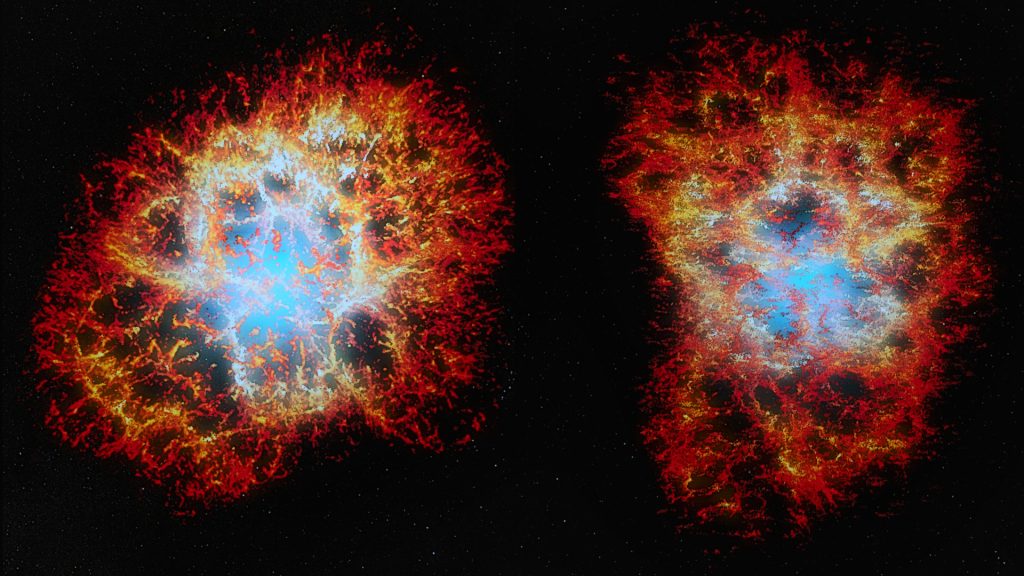3D Reconstruction of Iconic Stellar Explosion Reveals an Unexpected Honeycomb Heart
Using the powerful instrument SITELLE on the Canada-Hawaii-France Telescope (CFHT) in Mauna Kea, Hawaii, astronomers have mapped the iconic supernova remnant, the Crab Nebula, in unprecedented detail and have created a realistic three-dimensional reconstruction. These data of the stellar explosion’s debris field reveal a never-before-seen “heart-shaped” morphology and show that its wisps of gas filaments have an intricate honeycomb-like arrangement.

The Crab (Messier 1) has long been an intensely studied object by amateur and professional astronomers. Ever since historians first linked the remnant with the “guest star” spotted by Chinese astronomers on July 4 1054 CE, thousands of papers spanning many branches of physics and astronomy have been written on it. However, despite this rich history of investigation, many questions remain about what type of star was originally there and how the explosion proceeded.
Researcher Thomas Martin, member of the Center for Research in Astrophysics of Quebec (CRAQ), who led this study at Université Laval, hopes to answer these questions using the new 3D reconstruction. “Astronomers will now be able to move around and inside the Crab Nebula and study its filaments one by one,” said Martin. “Similar to how an investigative squad studies the distribution and chemistry of debris left behind by a bomb, we can use this reconstruction to learn more about the original supernova.” Coauthor Dan Milisavljevic, an assistant professor at Purdue University and supernova expert, concluded that “the fascinating honeycomb morphology seems to disfavour the most popular explanation about how the original explosion proceeded.”
The “hyperspectral” dataset used to create the 3D reconstruction was made possible by SITELLE, which utilizes a Michelson interferometer design instead of more classical dispersive techniques. This important difference provides unique advantages, and enabled SITELLE to obtain the highest number of high-resolution spectra (310,000) ever obtained of every point of the Crab. SITELLE is the result of a joint collaboration between Université Laval, ABB Inc.-Québec, Université de Montréal and the CFHT, under the scientific leadership of coauthor Professor Laurent Drissen, also a CRAQ member at Université Laval. “SITELLE was designed with objects like the Crab nebula in mind but its wide field of view and adaptability make it ideal to study nearby galaxies and even clusters of galaxies at large distances”, said Drissen.
Supernova explosions are among the most energetic and influential phenomena in the universe. Consequently, Milisavljevic believes that “as citizens of the universe it is vital that we understand this fundamental process that makes life possible. SITELLE will play a new and exciting role in this understanding.”
Video :
Made from hundreds of thousands of measurement points represented by small cubes, this animation presents a 3-dimensional view of the Crab Nebula as one would see it through the lens of a camera moving around and inside it. The speed of the ionized gas, measured by SITELLE, has been spatially translated by assuming the material is expanding without acceleration. The only artistic intervention in this animation is the bluish sphere in the center of the nebula, which represents the light emitted by the wind from the pulsar. The Milky Way galaxy in the background (NASA / Goddard Space Flight Center Scientific Visualization Studio) adequately simulates the point of view of a person moving near the nebula. The soundtrack comes from the electromagnetic frequencies of the data which have been “translated” into sound frequencies, then sampled and mixed.
Paper: Accepted for publication by the Monthly Notices of the Royal Astronomical Society; a copy is available at https://arxiv.org/abs/2101.02709
Source:
Thomas Martin
Université Laval
thomas.martin.1@ulaval.ca
Dan Milisavljevic
Purdue University
dmilisav@purdue.edu
Laurent Drissen
Université Laval
ldrissen@phy.ulaval.ca
